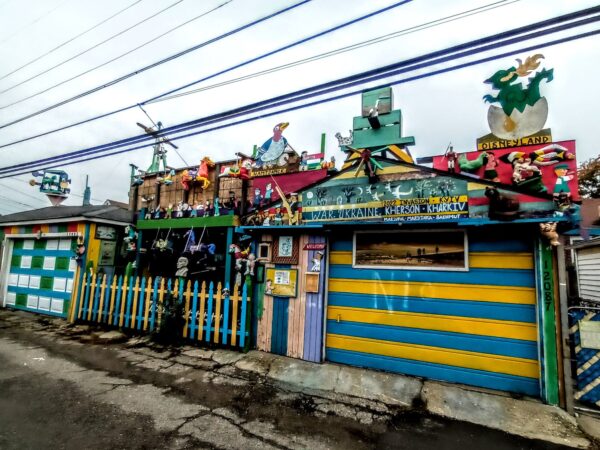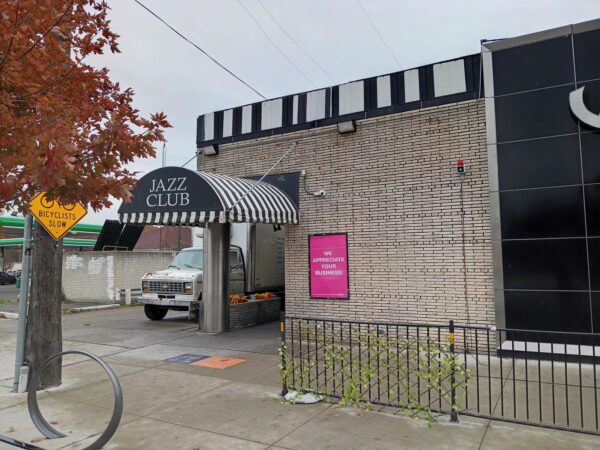It’s the last day of this trip and, other than one brief photo stop to serve as the overture, I’m going to start this post with the cadenza because I heard a symphony in the middle. I made my first stop at 1451 Brush Street to take this photo

and no, it wasn’t to send “Greetings from Detroit” or to get a photo of the car that looks like it’s blowing flowers out its tailpipe. Appropriately, the Stevie Wonder mural is on the Music Hall Center for the Performing Arts. Richard Wilson, a London based artist told the Detroit Free Press, “For me, he’s the greatest living singer, songwriter, and musician. In 300 years, I’m sure he’ll be looked (at) as a Beethoven, Mozart, Bach – that kind of epic influence on humanity.”
In fact, Wilson was so passionate about the project that not only did he bring the idea to Vince Paul, president and artistic director of Music Hall, but he completed it entirely at his own expense. This included not just his time but his travel, lodging, equipment, and paint. In May 2019, he told the Detroit Free Press, “Every day I’m having those moments where I’m like, ‘Oh my God, this is ridiculous. Why am I doing this?’ I’m a struggling artist. I’m literally living off savings I’ve got from having sold my apartment a few years ago. I just think life’s too short. I’ve got to make it happen.” And so he did, finishing in July of that year.
Hamtramck Disneyland.
If you immediately thought, “He had to have seen this on AO or RA, you’d be right. I learned about it on both. However, it’s not quite as obscure as one might think. If you enter the term into your search engine of choice, you’re likely see results not only from the site’s own web page but a Wikipedia page, Facebook and Instagram pages, and even an appearance on TripAdvisor. So, while it’s someplace that’s a bit off the normal tourist path, it’s not quite as obscure as it first appears to be.
Hamtramck Disneyland is a folk art project that emerged from the hands and mind of Dmytro Szylak. Szylak was born in Ukraine in 1922 or 1923 and, after living for a short time in Germany, moved to the United States sometime in the 1950s. He settled in Michigan and found a job at General Motors where he worked for thirty years before retiring in the mid 1980s. And it was then that he began working on the project that has come to be called Hamtramck Disneyland.

Szylak owned two adjoining properties on Klinger Street – a residential neighborhood in Hamtramck – and his initial work began on top of the garages in the back of the two properties.
He’s reported to have worked on it nearly every day until his death in 2015. It’s said that while he was alive he would frequently stop and chat with the people who came to see his creation. Although one obituary says he “never seemed to tire talking about his work” and Atlas Obscura wrote,
Unlike many other hermetic outsider artists, Dmytro was quite approachable and would give you a personal tour of the site for a small donation. Among the perks of the tour were seeing Dmytro turn on many of the various moving parts of the building-engulfing sculpture that aren’t usually turned on. It is a testament to Dmytro’s construction skill that the structure had survived the harsh Michigan winters so well.
I couldn’t find any source where he described his artistic vision if, indeed, he had one.
In his obituary in the Hamtramck Review he’s quoted as having said in a short documentary about the work, “After retirement, I think about what I’ll do. I make a hobby on two garages, on the roof. A lot of people come over. All countries, all world, (come) to see my Disneyland. And a lot of people say, ‘Incredible.’ Everybody is happy.”
Aided by the vision expressed by Hamtramck mayor Karen Majewski, who called the work, “a landmark and tourist attraction, as well as an expression of Mister Szylak’s life and artistic vision” the city committed to preserving it. Her vision was aided by Hatch Art, an organization that operates an art gallery and studios in Hamtramck’s former police station and which ultimately took ownership of Hamtramck Disneyland in May 2016.
For some time, Hatch Art used the property to support an Artists in Residence program. However, that program was suspended in January 2023 to allow them to “work to stabilize Hamtramck Disneyland, physically and financially.”

Although Atlas Obscura and the Hatch Art websites provide the address at 12087 Klinger Street, and a good GPS will guide you there, you won’t see Hamtramck Disneyland when you arrive at that destination. The installation is in the back so you need find your way into the alley behind the houses. If you’ve followed your GPS this far and are coming from Detroit, it will have you turn onto Klinger Street before you reach the alley. This means you’ll need to pass the address, turn left into another alley just before you reach Carpenter Street then left again into the alley behind the houses you just passed. Alternatively, you can pass Klinger Street and turn right into the alley from Commor Avenue.
No one else was there when I arrived on the chilly, misty Saturday afternoon with a hint of winter wind that wasn’t whispering to me that it wanted to be my friend. But soon a car approached from Commor Avenue, stopped, and from it emerged two young women adorned with numerous tattoos, pierced body parts, and sporting the flamboyant hair color typical of people their age. Of course, we immediately began a conversation and I learned that they were told to look for a message on a very specific element interwoven into Szylak’s creation. I spent a few minutes looking for it with them but, finding no success, went on my way wanting to get out of the mist and make one additional stop before ending the day by meeting the parents of a Maryland volleyball player for dinner.
A final photo-op.
My last stop for the day and the trip would be to take a photo of Baker’s Jazz Club also called Baker’s Keyboard Lounge. Why, you wonder? You can find the answer on the visitdetroit website where the first sentence describes it: “Welcome to the Historic Baker’s Keyboard Lounge, the oldest Jazz (sic) club in the world.” Baker’s opened in 1934 and whether the claim is true or not, it has certainly hosted some of the jazz world’s most celebrated figures including Ella Fitzgerald, Miles Davis, Oscar Peterson, George Shearing, Sarah Vaughn, Joe Williams, Maynard Ferguson, Cab Calloway, Woody Herman, Modern Jazz Quartet, and Nat “King” Cole. So, while I wouldn’t be able to enter in the middle of a Saturday afternoon, given the place music occupies in my life, I can at least say I saw its outside.

Keep in mind that I started this post at the end of the day so there’s more on tap. While you’re waiting, you can look at the rest of my photos from Hamtramck Disneyland and one more of Baker’s.